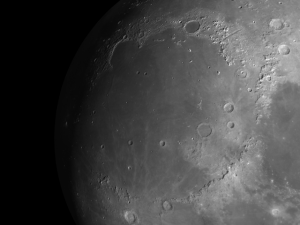The week of June 5-11 takes us from lunar Day 11 to the beginning of Day 17. This week we will highlight Doppelmayer and Mare Imbrium, viewable on Monday night.
 Doppelmayer: [SW/M5] Doppelmayer crater, on the southwest shore of Mare Humorum, is another great example of crater subsidence. The inundated top of the north rim of Doppelmayer is so close to the surface that, under low lighting, we can see its ghost image bleeding through to the surface as a wrinkle ridge.
Doppelmayer: [SW/M5] Doppelmayer crater, on the southwest shore of Mare Humorum, is another great example of crater subsidence. The inundated top of the north rim of Doppelmayer is so close to the surface that, under low lighting, we can see its ghost image bleeding through to the surface as a wrinkle ridge.
Mare Imbrium: [±NW/F8] The Imbrium basin is so large that it has taken four days for the terminator to completely cross it. It was created 3.9 billion years ago when an asteroid 60 miles in diameter slammed into the Moon at 10 miles per second and blasted out a 720-mile-wide crater, which is revealed in its entirety tonight.
 Mare Imbrium was at one time a spectacular multi-ring basin like Mare Orientale (most of which remains out of sight beyond the western limb of the Moon). Fortunately, segments of the original multi-ring features of Imbrium remain in the form of four stunning mountain ranges: the Alps, the Caucasus, the Apennines, and the Carpathians [±F10–best seen around Days 7-8]. Unlike mountain ranges on the Earth, these ranges did not form by tectonic uplift; they were blasted into place by the impact that excavated Mare Imbrium (much like a billiard ball dropped into a tub of thick, viscous mud will leave a conspicuous circle of ridges around the point of impact).
Mare Imbrium was at one time a spectacular multi-ring basin like Mare Orientale (most of which remains out of sight beyond the western limb of the Moon). Fortunately, segments of the original multi-ring features of Imbrium remain in the form of four stunning mountain ranges: the Alps, the Caucasus, the Apennines, and the Carpathians [±F10–best seen around Days 7-8]. Unlike mountain ranges on the Earth, these ranges did not form by tectonic uplift; they were blasted into place by the impact that excavated Mare Imbrium (much like a billiard ball dropped into a tub of thick, viscous mud will leave a conspicuous circle of ridges around the point of impact).
The Imbrium basin later filled up with lava that had the viscosity of hot maple syrup and therefore flowed very quickly, turning the mare basins into what were truly, for a time, liquid seas. (Early observers of the Moon were not so far off base after all when they called these features “seas.”)
======================
It is highly recommended that you get a copy of Sky and Telescope’s Field Map of the Moon, the very finest Moon map available for use at the telescope. It is available for $10.95 at www.skyandtelescope.com and on Amazon. All features mentioned in this blog will be keyed to the grid on the Field Map and will look like this: Plato: [NW/D9]
Credits:
Courtesy of Gray Photography of Corpus Christi, Texas
Lunar photos: NASA / USGS / BMDO / LROC / ASU / DLR / LOLA / Moon Globe. Used by permission
- Hippalus Rilles on the Moon - April 15, 2024
- Moon Crater Janssen: How New Moon Craters are Superimposed on Top of Older Craters - April 8, 2024
- Crater Longomontanus on the Moon - April 1, 2024